Access Control in Networking-
Before you go through this article, make sure that you have gone through the previous article on Access Control.
We have discussed-
- Access Control is a mechanism that controls the access of stations to the transmission link.
- Broadcast links require the access control mechanism.
- There are various access control methods-
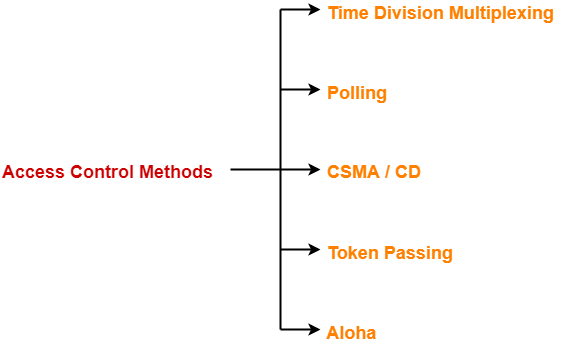
In this article, we will discuss about Token Passing.
Before discussing Token Passing, let us discuss few important concepts required for the discussion.
Time Conversions-
In token passing,
- Time may be expressed in seconds, bits or meters.
- To convert the time from one unit to another, we use the following conversion chart-
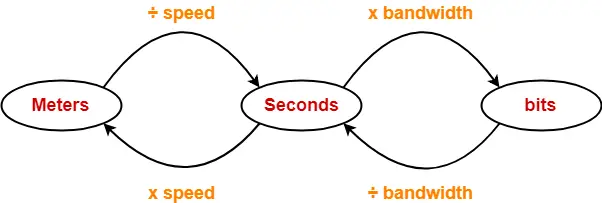
Conversion Chart
Token Passing Terminology-
The following terms are frequently used-
- Token
- Ring Latency
- Cycle Time
1. Token-
- A token is a small message composed of a special bit pattern.
- It represents the permission to send the data packet.
- A station is allowed to transmit a data packet if and only if it possess the token otherwise not.
2. Ring Latency-
| Time taken by a bit to complete one revolution of the ring is called as ring latency. |
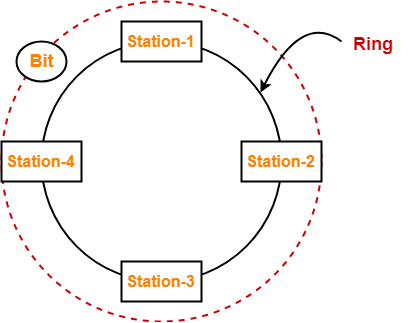
Let us derive the expression for ring latency.
If-
- Length of the ring = d
- Speed of the bit = v
- Number of stations = N
- Bit delay at each station = b
(Bit delay is the time for which a station holds the bit before transmitting to the other side)
Then-
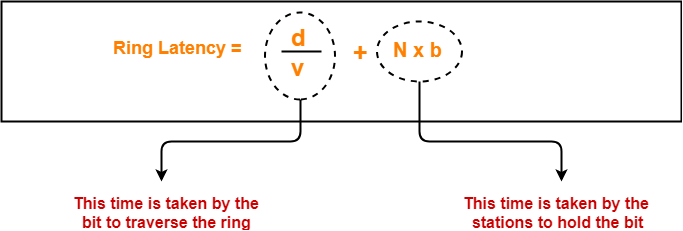
Notes-
- d / v is the propagation delay (Tp) expressed in seconds.
- Generally, bit delay is expressed in bits.
- So, both the terms (d / v and N x b) have different units.
- While calculating the ring latency, both the terms are brought into the same unit.
- The above conversion chart is used for conversion.
After conversion, we have-
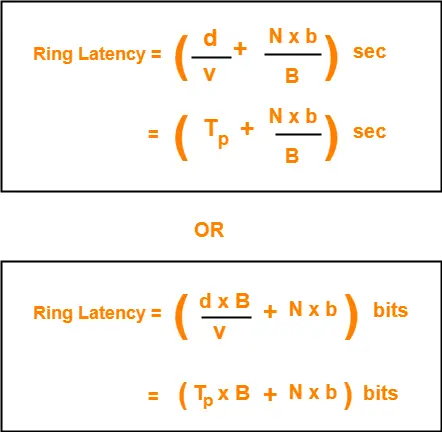
3. Cycle Time-
| Time taken by the token to complete one revolution of the ring is called as cycle time. |
If-
- Length of the ring = d
- Speed of the bit = v
- Number of stations = N
- Token Holding Time = THT
(Token Holding Time is the time for which a station holds the token before transmitting to the other side)
Then-
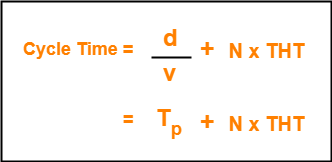
Now, we start discussing about Token Passing Access Control Method.
Token Passing-
In this access control method,
- All the stations are logically connected to each other in the form of a ring.
- The access of stations to the transmission link is governed by a token.
- A station is allowed to transmit a data packet if and only if it possess the token otherwise not.
- Each station passes the token to its neighboring station either clockwise or anti-clockwise.
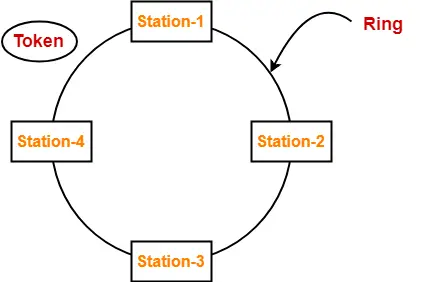
Assumptions-
Token passing method assumes-
- Each station in the ring has the data to send.
- Each station sends exactly one data packet after acquiring the token.
Efficiency-
| Efficiency (η) = Useful Time / Total Time |
In one cycle,
- Useful time = Sum of transmission delay of N stations since each station sends 1 data packet = N x Tt
- Total Time = Cycle time = Tp + N x THT
Thus,

Token Holding Time depends on the strategy implemented.
Token Passing Strategies-
The following 2 strategies are used in token passing-

- Delayed Token Reinsertion (DTR)
- Early Token Reinsertion (ETR)
1. Delayed Token Reinsertion-
In this strategy,
- Station keeps holding the token until the last bit of the data packet transmitted by it takes the complete revolution of the ring and comes back to it.
Working-
After a station acquires the token,
- It transmits its data packet.
- It holds the token until the data packet reaches back to it.
- After data packet reaches to it, it discards its data packet as its journey is completed.
- It releases the token.
The following diagram illustrates these steps for station-1. Same procedure is repeated at every station.
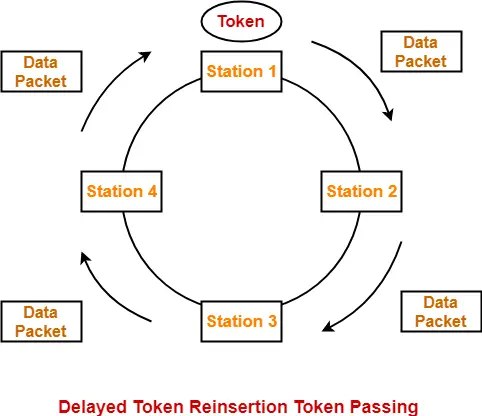
Token Holding Time-
| Token Holding Time (THT) = Transmission delay + Ring Latency |
We know,
- Ring Latency = Tp + N x bit delay
- Assuming bit delay = 0 (in most cases), we get-
| Token Holding Time = Tt + Tp |
Efficiency-
Substituting THT = Tt + Tp in the efficiency expression, we get-
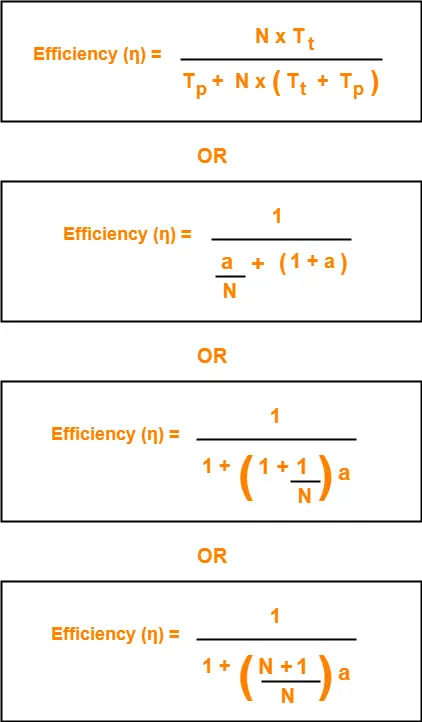
2. Early Token Reinsertion-
In this strategy,
- Station releases the token immediately after putting its data packet to be transmitted on the ring.
Working-
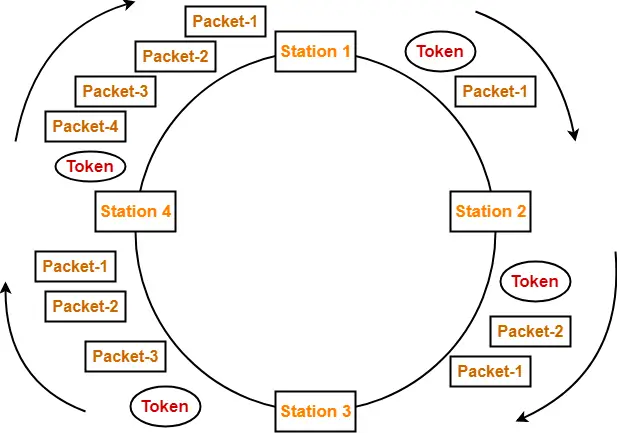
Step-01: At Station-1:
Station-1
- Acquires the token
- Transmits packet-1
- Releases the token
Step-02: At Station-2:
Station-2
- Receives packet-1
- Transmits packet-1
- Acquires the token
- Transmits packet-2
- Releases the token
Step-03: At Station-3:
Station-3
- Receives packet-1
- Transmits packet-1
- Receives packet-2
- Transmits packet-2
- Acquires the token
- Transmits packet-3
- Releases the token
Step-04: At Station-4:
Station-4
- Receives packet-1
- Transmits packet-1
- Receives packet-2
- Transmits packet-2
- Receives packet-3
- Transmits packet-3
- Acquires the token
- Transmits packet-4
- Releases the token
Step-05: At Station-1:
- Receives packet-1
- Discards packet-1 (as its journey is completed)
- Receives packet-2
- Transmits packet-2
- Receives packet-3
- Transmits packet-3
- Receives packet-4
- Transmits packet-4
- Acquires the token
- Transmits packet-1 (new)
- Releases the token
In this manner, the cycle continues.
Token Holding Time-
| Token Holding Time (THT) = Transmission delay of data packet = Tt |
Efficiency-
Substituting THT = Tt in the efficiency expression, we get-

Differences between DTR and ETR-
| Delay Token Retransmission (DTR) | Early Token Retransmission (ETR) |
| Each station holds the token until its data packet reaches back to it. | Each station releases the token immediately after putting its data packet on the ring. |
| There exists only one data packet on the ring at any given instance. | There exists more than one data packet on the ring at any given instance. |
| It is more reliable than ETR. | It is less reliable than DTR. |
| It has low efficiency as compared to ETR. | It has high efficiency as compared to ETR. |
Important Notes-
Note-01:
In token passing,
- It is the responsibility of each transmitting station to remove its own data packet from the ring.
Note-02:
While solving questions,
- If the strategy used is not mentioned, then consider Early Token Retransmission strategy.
To gain better understanding about Token Passing Method,
Next Article- Practice Problems On Token Passing
Get more notes and other study material of Computer Networks.
Watch video lectures by visiting our YouTube channel LearnVidFun.

